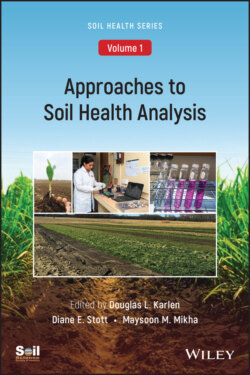Читать книгу Approaches to Soil Health Analysis, Volume 1 - Группа авторов - Страница 7
Оглавление
Foreword
Soil science receives increasing attention by the international policy arena and publication of this comprehensive “Soil Health” book by the Soil Science Society of America (SSSA) and Wiley International is therefore most welcome at this point in time. Striving for consensus on methods to assess soil health is important in positioning soil science in a societal and political discourse that, currently, only a few other scientific disciplines are deeply engaged in. Specifically, increasing the focus on sustainable development provides a suitable “point on the horizon” that provides a much needed focus for a wide range of activities. Sustainable development has long been a likeable, but still rather abstract concept. The United Nations General Assembly acceptance of seventeen Sustainable Development Goals (SDGs) by 193 Governments in 2015 changed the status of sustainable development by not only specifying the goals but also defining targets, indicators, and seeking commitments to reach those goals by 2030 (https://www.un.org/sustainabledevelopment‐goals). In Europe, the Green Deal, accepted in 2019, has targets and indicators corresponding to those of the SDGs (https://ec.europa.eu/info/strategy/european‐green‐dealsoil).
So far, soil scientists have not been actively engaged in defining SDG targets, which is unfortunate considering soil functions contribute significantly to ecosystem services that, in turn, contribute to the SDGs. The connections are all too obvious for soil scientists, but not necessarily so for scientists in other disciplines, politicians, or the public at large. For example, adequate production of food (SDG2) is impossible without healthy soil. Ground‐ and surface‐water quality (SDG6) are strongly influenced by the purifying and infiltrative capacities of soils. Carbon capture through increases in soil organic carbon (SOC) is a major mechanism contributing to the mitigation of an increasingly variable climate (SDG13) and living soils as an integral part of living landscapes are a dominant source of biodiversity (SDG15) (Bouma, 2014; Bouma et al., 2019). With complete certainty, we can show that healthy soils make better and more effective contributions to ecosystem services than unhealthy ones! This also applies when considering the recently introduced Soil Security concept, which articulates the 5 C’s: soil capability, condition, capital, connectivity, and codification (Field et al., 2017). A given soil condition can be expressed in terms of soil health, whereas soil capability defines potential conditions, to be achieved by innovative soil management, thus increasing soil health to a characteristically attainable level for that particular soil. Healthy soils are a capital asset for land users; connectivity emphasizes interactions among land users, citizens, and politicians that are obviously important, especially when advocating measures to increase soil health that may initially lack societal support. Finally, codification is important because future land use rules and regulations could benefit by being based on quantitative soil health criteria, thus allowing a reproducible comparison between different soils.
These volumes provide an inspiring source of information to further evaluate the soil health concept, derive quantitative procedures that will allow more effective interaction among land users, and information needed to introduce soil science into laws and regulations. The introductory chapters of Volume 1 present a lucid and highly informative overview of the evolution of the soil health movement. Other chapters discuss data needs and show that modern monitoring and sensing techniques can result in a paradigm shift by removing the traditional data barriers. Specifically, these new methods can provide large amounts of data at relatively low cost. The valuable observation is made that systems focusing only on topsoils cannot adequately represent soil behavior in space and time. Subsoil properties, expressed in soil classification, have significant and very important effects on many soil functions. Numerous physical, chemical and biological methods are reviewed in Volume 2. Six chapters deal with soil biological methods, correctly reflecting the need to move beyond the traditional emphasis on physical and chemical assessment methods. After all, soils are very much alive!
The book Soil Health nicely illustrates the “roots” of the soil health concept within the soil science profession. It also indicates the way soil health can provide “wings” to the profession as a creative and innovative partner in future environmental research and innovation.
Johan BoumaEmmeritus Professor of Soil ScienceWageningen UniversityThe Netherlands
References
1 Bouma, J. (2014). Soil science contributions towards Sustainable Development Goals and their implementation: Linking soil functions with ecosystem services. J. Plant Nutr. Soil Sci. 177(2), 111–120. doi:10.1002/jpln.201300646
2 Bouma, J., Montanarella, L., and Vanylo, G.E. (2019). The challenge for the soil science community to contribute to the implementation of the UN Sustainable Development Goals. Soil Use Manage. 35(4), 538–546. doi:10.1111/sum.12518
3 Field, D.J., Morgan, C.L.S., and Mc Bratney, A.C., editors. (2017). Global soil security. Progress in Soil Science. Springer Int. Publ., Switzerland. doi:10.1007/978‐3‐319‐43394‐3
